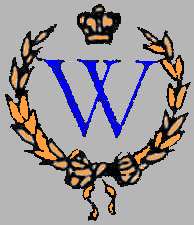




 Ursula's History Web
Ursula's History WebAn Heir for the House of Hohenzollern.
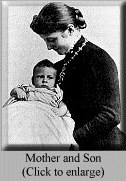 In the year of 1882, Kaiser Wilhelm I
and his Chancellor Bismarck ruled Germany. On May 6, the 23-yr. old
Prince Wilhelm, later Kaiser Wilhelm II, called through the window at
the Marmorpalais in Potsdam
when he saw his father " He is here, Papa, he is here, a son."
In the year of 1882, Kaiser Wilhelm I
and his Chancellor Bismarck ruled Germany. On May 6, the 23-yr. old
Prince Wilhelm, later Kaiser Wilhelm II, called through the window at
the Marmorpalais in Potsdam
when he saw his father " He is here, Papa, he is here, a son."
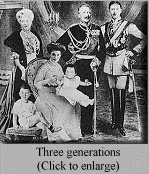 Three living generations of
Hohenzollerns seemed to have secured a happy future. The Kaiser, who
was
85 years old, was overcome with emotion: "That God in his wisdom and
mercy has bestowed such a blessing on an old man!"
The parents of the new Prince, Prince Wilhelm and his wife Auguste
Viktoria of Schleswig-Holstein, christened the baby Friedrich Wilhelm
Viktor Ernst.
Three living generations of
Hohenzollerns seemed to have secured a happy future. The Kaiser, who
was
85 years old, was overcome with emotion: "That God in his wisdom and
mercy has bestowed such a blessing on an old man!"
The parents of the new Prince, Prince Wilhelm and his wife Auguste
Viktoria of Schleswig-Holstein, christened the baby Friedrich Wilhelm
Viktor Ernst.
The formative years.
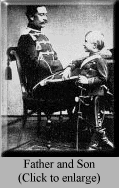 The first few years the Prince spent at
the Marmorpalais in Potsdam, the residence of his father. An English
Governess was entrusted with his early education. In 1887, at age 5,
the future Crown Prince had the chance to use the English language. His
parents took him to London to celebrate his great grandmother
Victoria's 50 years of reign in England.
The first few years the Prince spent at
the Marmorpalais in Potsdam, the residence of his father. An English
Governess was entrusted with his early education. In 1887, at age 5,
the future Crown Prince had the chance to use the English language. His
parents took him to London to celebrate his great grandmother
Victoria's 50 years of reign in England.
For the Hohenzollern family and the politics of the Reich, the year 1888 was the year of the three Emperors. Kaiser Wilhelm I died on March 9. His son Friedrich III succeeded him. But Friedrich, who was married to Queen Victoria's eldest daughter Victoria, the Princess Royal, had been ill for some time. He suffered from cancer of the larynx. His reign lasted only 99 days. Friedrich III died on June 15. His oldest son, the 29-yr. old Crown Prince became Kaiser Wilhelm II. His oldest son, 6 year old Prince Wilhelm officially became the Crown Prince.
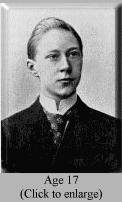 Now the carefree days at the
Marmorpalais were over. In summer he lived at the New
Palais in Potsdam and in winter he was with the family at the big
Palace in Berlin. His relationship with his father became more formal.
At age 10, he received the rank of Lieutenant of the First Infantry
Regiment, in accordance with tradition. When the Prince was 14 years
old, another important stage of his life began. Together with his
younger
brother Eitel Friedrich he was sent to the Academy at Ploen in
Schleswig-Holstein, where he became a cadet. It was the rule in the
Hohenzollern family, that every Prince had to learn a trade. Wilhelm
decided
to become a lathe operator (a drechsler). After 4 years at Ploen he
graduated on February 22, 1900.
Three days later he began his officer training in Potsdam, which had
been shortened from 9 months to 9 weeks. As he was 18 years old and had
become of age, according to the Hohenzollern House law, he began
active service with his regiment on May 6, 1900.
Now the carefree days at the
Marmorpalais were over. In summer he lived at the New
Palais in Potsdam and in winter he was with the family at the big
Palace in Berlin. His relationship with his father became more formal.
At age 10, he received the rank of Lieutenant of the First Infantry
Regiment, in accordance with tradition. When the Prince was 14 years
old, another important stage of his life began. Together with his
younger
brother Eitel Friedrich he was sent to the Academy at Ploen in
Schleswig-Holstein, where he became a cadet. It was the rule in the
Hohenzollern family, that every Prince had to learn a trade. Wilhelm
decided
to become a lathe operator (a drechsler). After 4 years at Ploen he
graduated on February 22, 1900.
Three days later he began his officer training in Potsdam, which had
been shortened from 9 months to 9 weeks. As he was 18 years old and had
become of age, according to the Hohenzollern House law, he began
active service with his regiment on May 6, 1900.
 For the occasion of his coming of age,
many guests attended the celebrations. Among the royal guests of Europe
were Kaiser Franz Josef of Austria, King Umberto of Italy and the Duke
of York, later the English
King George V.
For the occasion of his coming of age,
many guests attended the celebrations. Among the royal guests of Europe
were Kaiser Franz Josef of Austria, King Umberto of Italy and the Duke
of York, later the English
King George V.
The Crown Prince took part in active social life. A regimental comrade, Magnus, Freiherr von Braun, the father of the future rocket scientist Wernher von Braun, said of Wilhelm "The Crown Prince was an open, dependable comrade who cheerfully did his duty. The Ladies liked him because of his charm. He was honorable, tactful and a Grand Seigneur of the first class."
The death of his great grandmother Queen Victoria brought the Crown Prince to London in 1901, when he accompanied his father, the Kaiser. A few days after the funeral, on February 4, 1901, his godfather and his father's first cousin King Edward VII decorated him with the Order of the Garter.
 Another journey took Wilhelm to Vienna
to visit Kaiser Franz Josef. His parents were looking for a suitable
wife for him, and possibility existed in the person of a Princess from
the House of Cumberland. This however did not come about. After his
return from Austria, he went 2 years to the University of Bonn where he
studied civil law and administration. In 1903, on request of the
Kaiser, the Crown Prince traveled to St. Petersburg. The visit was to
cement the friendship between the two countries, as well as nourish the
blood ties that existed between the Romanovs
and Hohenzollerns. He was well liked at the court of the Tsar.
Another journey took Wilhelm to Vienna
to visit Kaiser Franz Josef. His parents were looking for a suitable
wife for him, and possibility existed in the person of a Princess from
the House of Cumberland. This however did not come about. After his
return from Austria, he went 2 years to the University of Bonn where he
studied civil law and administration. In 1903, on request of the
Kaiser, the Crown Prince traveled to St. Petersburg. The visit was to
cement the friendship between the two countries, as well as nourish the
blood ties that existed between the Romanovs
and Hohenzollerns. He was well liked at the court of the Tsar.
In the same year the Crown Prince and his brother Prince Eitel Friedrich paid a visit to Turkey's Sultan Abdul Hamid. This visit was to further Turkish-German friendship. Both Princes were very much taken with the oriental festivities held in their honor. After his return, the Crown Prince was promoted to Captain on the occasion of his 21st birthday.
The Crown Prince falls in love.
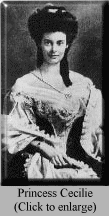 Princess Cecilie of
Mecklenburg-Schwerin came to the attention of the Kaiser and his wife
as a possible bride for their son. The Crown Prince attended the
wedding of Friedrich Franz IV of Mecklenburg-Schwerin with Princess
Alexandra of Hanover on July 4, 1904. There he met the 17-year-old
sister of the bridegroom, Princess Cecilie. This beautiful girl left an
overwhelming impression on the Crown Prince.
After his return to Potsdam he could not hide his affection. Pretty
soon, arrangements were under way
for the upcoming nuptials.
Princess Cecilie of
Mecklenburg-Schwerin came to the attention of the Kaiser and his wife
as a possible bride for their son. The Crown Prince attended the
wedding of Friedrich Franz IV of Mecklenburg-Schwerin with Princess
Alexandra of Hanover on July 4, 1904. There he met the 17-year-old
sister of the bridegroom, Princess Cecilie. This beautiful girl left an
overwhelming impression on the Crown Prince.
After his return to Potsdam he could not hide his affection. Pretty
soon, arrangements were under way
for the upcoming nuptials.
Princess Cecilie.
 Princess Cecilie was the third child of
the Grand Duke Friedrich Franz III and his wife the Grand Duchess
Anastasia Michailowna Romanov, a niece of Tsar Alexander II. She was
born on September 20, 1886 at the Palace in Schwerin. Her father was
ill and the family spent six month of the year in the South of France
in warmer climate trying to improve his health. Cecilie learned to
speak French fluently, as well as German,
English and Russian.
Princess Cecilie was the third child of
the Grand Duke Friedrich Franz III and his wife the Grand Duchess
Anastasia Michailowna Romanov, a niece of Tsar Alexander II. She was
born on September 20, 1886 at the Palace in Schwerin. Her father was
ill and the family spent six month of the year in the South of France
in warmer climate trying to improve his health. Cecilie learned to
speak French fluently, as well as German,
English and Russian.
In Cannes they met interesting personages. At Villa Wenden Cecilie met King Edward VII as well as the widow of Napoleon III, the former Empress Eugenie. They also met Romanov relatives and family members from Mecklenburg. When Queen Victoria visited Nice, she received Cecilie and her mother in the Queen's suite at the Regina-Palace -Hotel. Cecilie's father died in 1897. Shortly after her sister Alexandrine married Prince Christian of Denmark, later King Christian X. Cecilie's mother was only 39 years old when her husband died. She was a passionate sportswoman, involved in tennis and equestrian sports, which in her time was often thought eccentric by others. Her many interests made travel a necessity, and often she was separated from Cecilie.
Princess Cecilie paid long visits to the Russian court and with her grandfather, the Grand Duke Michael Nikolajewich, which left lasting impressions. In 1903 her grandfather suffered a stroke. He was brought to Cannes where Cecilie helped to nurse him for a long time. Cecilie was a most suitable young lady for the German Crown Prince, who later said "I loved her on first sight."
The Royal Wedding.
 The engagement took place on September
4, 1904. Cecilie visited her future husband and his parents in Potsdam
a month later. Accompanied by her brother and his wife, she arrived by
train and was taken by carriage to the New Palais. Princess Viktoria
Luise, the only daughter of the Kaiser was 12 years old. Much later she
spoke of her first meeting with Cecilie " I can still see her how she
looked on this October day in 1904. She was so beautiful; it was like a
dream. She wore a pink ensemble with a large matching hat, which made a
stark contrast to her dark hair and her large soulful dark eyes. And
her face glowed with sincerity
and warmth. I thought she truly looked a like a fairy tale princess. I
can not remember ever having seen such charm and natural beauty again."
The visit was filled with plans for the wedding, which was set for June
6,
1905.
The engagement took place on September
4, 1904. Cecilie visited her future husband and his parents in Potsdam
a month later. Accompanied by her brother and his wife, she arrived by
train and was taken by carriage to the New Palais. Princess Viktoria
Luise, the only daughter of the Kaiser was 12 years old. Much later she
spoke of her first meeting with Cecilie " I can still see her how she
looked on this October day in 1904. She was so beautiful; it was like a
dream. She wore a pink ensemble with a large matching hat, which made a
stark contrast to her dark hair and her large soulful dark eyes. And
her face glowed with sincerity
and warmth. I thought she truly looked a like a fairy tale princess. I
can not remember ever having seen such charm and natural beauty again."
The visit was filled with plans for the wedding, which was set for June
6,
1905.
 With great expectations and fully aware
of her future obligations, the 18 year old Princess Cecilie arrived in
Berlin. After being greeted by the Kaiser, she was led into Bellevue
Palace, passing the guard of honor
standing at attention. Then came the traditional drive of the bride
from Bellevue Palace to the big City Palace in the center of Berlin.
The weather was beautiful and crowds were lining the streets. Many
guests from all over Europe were already there to greet the Princess.
The next day the royal couple attended a service at the Berlin
cathedral. (The Berlin Dom, which is now restored)
With great expectations and fully aware
of her future obligations, the 18 year old Princess Cecilie arrived in
Berlin. After being greeted by the Kaiser, she was led into Bellevue
Palace, passing the guard of honor
standing at attention. Then came the traditional drive of the bride
from Bellevue Palace to the big City Palace in the center of Berlin.
The weather was beautiful and crowds were lining the streets. Many
guests from all over Europe were already there to greet the Princess.
The next day the royal couple attended a service at the Berlin
cathedral. (The Berlin Dom, which is now restored)
On June 6, 1905, the wedding began with a civil ceremony conducted by the Kaiser's Minister von Wedel, in the presence of the Kaiser and his wife and Cecilie's mother and brother and sister. Then followed the Church wedding with Europe's royalty attending the ceremony, which was conducted by the Kaiser's Pastor Dryander. It was an exiting day for the royal couple, their families and friends, as well as for the whole of Germany. After the honeymoon the Kaiser designated the Marmorpalias in Potsdam as their official residence.
The next generation of Hohenzollerns.
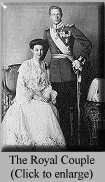
 In 1906 the shipping line North German
Lloyd asked the Crown Princess to christen their new Hapag- Ship
" Crown Princess Cecilie." The royal couple settled down to married
life. The crown Prince served as chief of his regiment in Potsdam.
The first years were carefree and happy. The birth of their first two
sons (Wilhelm 1906) and (Louis
Ferdinand 1907) gave them much joy. In 1909 their third son Hubertus
was born. The royal couple visited St. Petersburg and England in 1911.
In this year their fourth son Friedrich was born. But the year 1911 did
bring disappointment to the Crown Prince. The Kaiser had decided to
send him to Danzig, where he reported for duty in September 1911. His
father had objected to the immense popularity of the Crown Prince. He
hoped that in far away Danzig he would have fewer opportunities to
appear in public. But the Crown Prince was not easily deterred. On
November 9, 1911 he appeared at the Reichstag in Berlin, attending the
debate of the Morocco-crisis without permission of the Kaiser. A row
with his father followed. He returned to Danzig, and in spite of his
first disappointment about being posted there, he later called these
years "the happiest years of my life."
In 1906 the shipping line North German
Lloyd asked the Crown Princess to christen their new Hapag- Ship
" Crown Princess Cecilie." The royal couple settled down to married
life. The crown Prince served as chief of his regiment in Potsdam.
The first years were carefree and happy. The birth of their first two
sons (Wilhelm 1906) and (Louis
Ferdinand 1907) gave them much joy. In 1909 their third son Hubertus
was born. The royal couple visited St. Petersburg and England in 1911.
In this year their fourth son Friedrich was born. But the year 1911 did
bring disappointment to the Crown Prince. The Kaiser had decided to
send him to Danzig, where he reported for duty in September 1911. His
father had objected to the immense popularity of the Crown Prince. He
hoped that in far away Danzig he would have fewer opportunities to
appear in public. But the Crown Prince was not easily deterred. On
November 9, 1911 he appeared at the Reichstag in Berlin, attending the
debate of the Morocco-crisis without permission of the Kaiser. A row
with his father followed. He returned to Danzig, and in spite of his
first disappointment about being posted there, he later called these
years "the happiest years of my life."
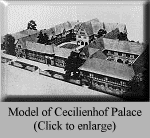 The royal couple wanted a home of their
own. While in Danzig they made plans. The Kaiser allotted a location in
Potsdam for the new residence and on December 29, 1912, the Kaiser
authorized his Minister to
pay 250000 Mark in each of the following four years for the
construction of the new residence.
The royal couple wanted a home of their
own. While in Danzig they made plans. The Kaiser allotted a location in
Potsdam for the new residence and on December 29, 1912, the Kaiser
authorized his Minister to
pay 250000 Mark in each of the following four years for the
construction of the new residence.
The First World War.
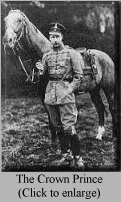 There were many signs of things to
come, but nobody took the situation very seriously in the early summer
of 1914. But events changed drastically when the news reached Potsdam
that Serbian Nationalists had murdered the Austrian Crown Prince Franz
Ferdinand and his wife on June 28, in the streets of Sarajewo.
Germany had treaty obligations with Austria. On July 29, 1914 the Crown
Prince was ordered back to Berlin. The Kaiser assigned him command over
the V Army, but in limited capacity because of dynastic considerations.
There were many signs of things to
come, but nobody took the situation very seriously in the early summer
of 1914. But events changed drastically when the news reached Potsdam
that Serbian Nationalists had murdered the Austrian Crown Prince Franz
Ferdinand and his wife on June 28, in the streets of Sarajewo.
Germany had treaty obligations with Austria. On July 29, 1914 the Crown
Prince was ordered back to Berlin. The Kaiser assigned him command over
the V Army, but in limited capacity because of dynastic considerations.
After the German declaration of War on France on August 3, the
Crown Prince joined his regiment, which saw action at the Battle of
Longwy. For his service the Crown Prince was awarded the Iron Cross.
Soon the winds of war changed, German troops had been close to Paris,
but came to a halt at the Marne. The bitter fighting and the heavy
losses of men and material made the Crown Prince write a memorandum
in which he stated that he favored an end to the senseless hostilities.
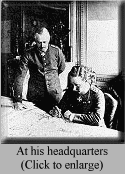 Russia was very much on his mind.
In 1917 the Crown Prince tried to persuade Chancellor Hollweg to sue
for a reasonable peace. This time a
firm refusal came from the High Command of the Army (Hindenburg and
Ludendorff) In another letter dated July 18, 1917 he tried again to
influence Reich politics. He brought forward several suggestions for
the possible achievement of Peace. Again, he was rebuffed. He was not
involved in the reform efforts in the fall of 1918; he was at the time
with his regiment. The peace negotiations were of the utmost importance
for the future of the House of Hohenzollern, as the opposing nations
demanded the abdication of the Kaiser. However, the Kaiser refused to
give up. At the beginning of November 1918, in view of the hopeless
situation on the fronts and the intolerable situation at home, a group
of sailors of the Imperial Navy refused to take their ships out for a
last senseless slaughter, and soon this revolution spread all through
Germany, reaching Berlin on November 9. The Kaiser was at his
headquarters and still refused to budge. Chancellor Max von Baden took
it upon himself to announce that the Kaiser of Germany and King of
Prussia, Wilhelm II, had decided to denounce the throne. His hand
forced in this way, the Kaiser was persuaded to seek asylum in neutral
Holland. He avoided capture but made it impossible to retain the
monarchy in Germany. Both the Kaiser and the Crown Prince signed the
document of abdication. With this, the 500-year-old dynasty had come to
an end, which had started in 1412 when Friedrich of Hohenzollern was
made Markgraf of Brandenburg. It is of interest to note that according
to the Encyclopedia Britannica, historians see Kaiser Wilhelm II more
and more as a participant rather than an instigator.
Russia was very much on his mind.
In 1917 the Crown Prince tried to persuade Chancellor Hollweg to sue
for a reasonable peace. This time a
firm refusal came from the High Command of the Army (Hindenburg and
Ludendorff) In another letter dated July 18, 1917 he tried again to
influence Reich politics. He brought forward several suggestions for
the possible achievement of Peace. Again, he was rebuffed. He was not
involved in the reform efforts in the fall of 1918; he was at the time
with his regiment. The peace negotiations were of the utmost importance
for the future of the House of Hohenzollern, as the opposing nations
demanded the abdication of the Kaiser. However, the Kaiser refused to
give up. At the beginning of November 1918, in view of the hopeless
situation on the fronts and the intolerable situation at home, a group
of sailors of the Imperial Navy refused to take their ships out for a
last senseless slaughter, and soon this revolution spread all through
Germany, reaching Berlin on November 9. The Kaiser was at his
headquarters and still refused to budge. Chancellor Max von Baden took
it upon himself to announce that the Kaiser of Germany and King of
Prussia, Wilhelm II, had decided to denounce the throne. His hand
forced in this way, the Kaiser was persuaded to seek asylum in neutral
Holland. He avoided capture but made it impossible to retain the
monarchy in Germany. Both the Kaiser and the Crown Prince signed the
document of abdication. With this, the 500-year-old dynasty had come to
an end, which had started in 1412 when Friedrich of Hohenzollern was
made Markgraf of Brandenburg. It is of interest to note that according
to the Encyclopedia Britannica, historians see Kaiser Wilhelm II more
and more as a participant rather than an instigator.
Exile.
The Kaiser left for Doorn, Holland on November 10, 1918. The Crown Prince followed two days later. He spent one week at Schloss Hillenraadt and then the government of The Netherlands sent him to the village of Oosterland on the island of Wieringen. The Prince arrived there on November 21 and moved into the Pastor's manse in Oosterland, accompanied by his valet Woelk and his wife.
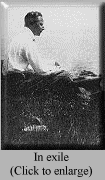 Princess Cecilie had decided to remain
in Germany and devote herself to the education of her six children.
After the 4 boys the Princess had given birth to 2 girls, (Alexandrine
1915) and (Cecilie 1917). Since the completion of their residence in
1917, the Princess had lived there with the children. The official name
of the
residence was "Cecilienhof." (In 1945 it became the place of the
Potsdam Conference).
Now, in 1918, the Princess took the children and moved in with her
mother-in law at the New Palais. They felt safer there in these
restless and dangerous times. A few days later, the Empress Auguste
Viktoria changed her mind and decided to follow her husband into exile.
Princess Cecilie however, remained steadfast in her decision to stay in
Germany to supervise her children's education. She spent some time
in Oels, Silesia at the estate they were allowed to keep. Her younger
children accompanied her --
her two oldest sons remained at Cecilienhof under the supervision of a
strict disciplinarian. They both attended the gymnasium at Potsdam and
tried to be like other children.
Princess Cecilie had decided to remain
in Germany and devote herself to the education of her six children.
After the 4 boys the Princess had given birth to 2 girls, (Alexandrine
1915) and (Cecilie 1917). Since the completion of their residence in
1917, the Princess had lived there with the children. The official name
of the
residence was "Cecilienhof." (In 1945 it became the place of the
Potsdam Conference).
Now, in 1918, the Princess took the children and moved in with her
mother-in law at the New Palais. They felt safer there in these
restless and dangerous times. A few days later, the Empress Auguste
Viktoria changed her mind and decided to follow her husband into exile.
Princess Cecilie however, remained steadfast in her decision to stay in
Germany to supervise her children's education. She spent some time
in Oels, Silesia at the estate they were allowed to keep. Her younger
children accompanied her --
her two oldest sons remained at Cecilienhof under the supervision of a
strict disciplinarian. They both attended the gymnasium at Potsdam and
tried to be like other children.
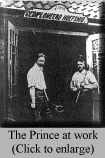 In the meantime, the inhabitants of the
island of Wieringen in Holland were not overjoyed with the presence
of the former German Crown Prince. Some even called him " the butcher
of Verdun." Life in the manse was very simple. No electricity, no
running water and a bath was an unheard of luxury. After the stressful
years of the war and the pandemonium of the abdication, the Prince
suddenly found himself in quiet surroundings with time to think. He
spent many weeks and months sitting by the window or by the sea,
pondering over past events and the role he had played in it. As time
past, the people on the island became friendlier and began to accept
his presence among them. The Prince enjoyed tinkering in the workshop
of the blacksmith Jan Luijt. After one year the Dutch government
relaxed certain restrictions, and in
September 1919 he received his first visitors in Oosterland: His two
youngest sons, Hubertus and Friedrich.
In the meantime, the inhabitants of the
island of Wieringen in Holland were not overjoyed with the presence
of the former German Crown Prince. Some even called him " the butcher
of Verdun." Life in the manse was very simple. No electricity, no
running water and a bath was an unheard of luxury. After the stressful
years of the war and the pandemonium of the abdication, the Prince
suddenly found himself in quiet surroundings with time to think. He
spent many weeks and months sitting by the window or by the sea,
pondering over past events and the role he had played in it. As time
past, the people on the island became friendlier and began to accept
his presence among them. The Prince enjoyed tinkering in the workshop
of the blacksmith Jan Luijt. After one year the Dutch government
relaxed certain restrictions, and in
September 1919 he received his first visitors in Oosterland: His two
youngest sons, Hubertus and Friedrich.
In February 1920 the Prince learned that his name appeared besides 895 others on a list of war criminals, which the Allies had compiled. He reacted openly and sent a memo to all Allied Heads of State: "If the Allied and Associated governments need a victim, please take me instead of the other 900 Germans who have committed no other crime than to fight for their country." The Prince met his father for the first time in exile on May 21, 1920. They discussed past events and the uncertain future. The Prince wrote later that he was extremely moved by this encounter.
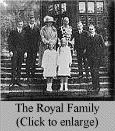 Besides working at the blacksmith
workshop and limited sports activities, the Prince wrote his memoirs
on the island of Wieringen. Many politicians in Germany called for his
return to Germany. He gave Chancellor Stresemann his word that he would
not interfere in any political activities. Finally, on Nov. 9
1923 he left the island to return home. It took three days by car to
reach Oels in Silesia, where his wife and children waited to greet him.
A short while later, they returned to Potsdam, where he saw the
Cecilenhof for
the first time since its completion. In the years that followed the
Prince enjoyed living in the beautiful home he had helped to plan in
better times, He also enjoyed his new status as a private citizen. He
was seen at
sports events and cultural and social festivities. The royal couple
enjoyed entertaining at Cecilienhof. Cecilie had learned to manage the
vast household. (Any visitor to Cecilienhof today will be surprised to
see that it resembles a grand English Country Manor, rather than an
ostentatious royal residence.)
Besides working at the blacksmith
workshop and limited sports activities, the Prince wrote his memoirs
on the island of Wieringen. Many politicians in Germany called for his
return to Germany. He gave Chancellor Stresemann his word that he would
not interfere in any political activities. Finally, on Nov. 9
1923 he left the island to return home. It took three days by car to
reach Oels in Silesia, where his wife and children waited to greet him.
A short while later, they returned to Potsdam, where he saw the
Cecilenhof for
the first time since its completion. In the years that followed the
Prince enjoyed living in the beautiful home he had helped to plan in
better times, He also enjoyed his new status as a private citizen. He
was seen at
sports events and cultural and social festivities. The royal couple
enjoyed entertaining at Cecilienhof. Cecilie had learned to manage the
vast household. (Any visitor to Cecilienhof today will be surprised to
see that it resembles a grand English Country Manor, rather than an
ostentatious royal residence.)
The Advent of Adolf Hitler.
As time went on, new events were shaping up in Germany. Hitler, an ambitious politician, paid his first visit to Cecilienhof in 1926. His party needed the backing of the Hohenzollerns at this time. Hitler dangled the " carrot ," telling the Prince that a restoration of the monarchy is entirely possible. The prince told him at the time " It is true, there was a time that I wanted to be the next Kaiser. But as you can see, I am a private citizen now, wearing tweeds and knickerbockers." Hitler approached the Prince again in 1932, asking for his support in the upcoming campaign. The Prince seemed interested, but told Hitler that for this he would need his father's approval. The letter came back from Holland, telling the Prince that he, William II, opposes all other form of government. He reminded his son that he would have to swear an oath to the republic....."and if you do that, I will disinherit you."
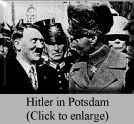 After his election, Hitler had a big
day in Potsdam on March 21, 1933. The Prince took part, wearing the
uniform of the Danzig Husars. Hitler visited Cecilienhof later that
day. After he left, Princess Cecilie told the servants to open the
doors and windows to "get the smell out ." There were some contacts
with Nazi officials, but the Prince tried to maintain his distance. He
again withdrew into private life. He traveled, sometimes alone, and
often with his wife. In 1936 the Royal couple gave a reception for
Charles Lindbergh, who had come to Berlin for the Olympic Games. In
1938 Prince Louis Ferdinand married the Russian Grand Duchess Kira. The
civil marriage took place in Potsdam, the Church wedding in Doorn,
Holland at
Kaiser Wilhelm's place, the grandfather of the bridegroom.
After his election, Hitler had a big
day in Potsdam on March 21, 1933. The Prince took part, wearing the
uniform of the Danzig Husars. Hitler visited Cecilienhof later that
day. After he left, Princess Cecilie told the servants to open the
doors and windows to "get the smell out ." There were some contacts
with Nazi officials, but the Prince tried to maintain his distance. He
again withdrew into private life. He traveled, sometimes alone, and
often with his wife. In 1936 the Royal couple gave a reception for
Charles Lindbergh, who had come to Berlin for the Olympic Games. In
1938 Prince Louis Ferdinand married the Russian Grand Duchess Kira. The
civil marriage took place in Potsdam, the Church wedding in Doorn,
Holland at
Kaiser Wilhelm's place, the grandfather of the bridegroom.
The Second World War.
The first year of the war brought sad news to Potsdam. On May 23, 1940 the eldest son of the royal couple Prince Wilhelm was badly wounded in France and died three days later. The parents were devastated. Wilhelm was buried in Sans Souci in Potsdam on May 29. More than 50000 people showed up for the funeral. Hitler took this as a demonstration FOR the monarchy. He issued an order that in the future no members of former reigning houses will do active duty on any front.
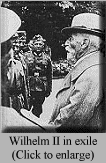 On June 4, 1941 The German Kaiser died
in exile, in Doorn, Holland. The Crown Prince had no easy time to honor
his father's wishes in regard to the funeral. Hitler wanted a state
funeral with all the pomp, where he would walk behind the casket,
showing Germany and the world that he indeed was the legitimate
successor. The Hohenzollerns closed ranks. They buried the Kaiser in
Doorn, Holland. It was according to his wishes, laid down in his last
will and testament, dated in 1933:
"........ and at the place opposite the house where my bust stands in
front of the Rhododendron bushes you should put my coffin. Put flowers
in brilliant colors around it. Keep the ceremony simple, quiet and
dignified. No delegations from home, no swastikas, no wreaths of any
kind. Do the same for Her Majesty in case of her death in Doorn. Should
I die in Potsdam, my remains are to be put in the Mausoleum. A strictly
military funeral without swastika flags, no obituaries, hymn singing or
prayers.
signed: Wilhelm II R".
On June 4, 1941 The German Kaiser died
in exile, in Doorn, Holland. The Crown Prince had no easy time to honor
his father's wishes in regard to the funeral. Hitler wanted a state
funeral with all the pomp, where he would walk behind the casket,
showing Germany and the world that he indeed was the legitimate
successor. The Hohenzollerns closed ranks. They buried the Kaiser in
Doorn, Holland. It was according to his wishes, laid down in his last
will and testament, dated in 1933:
"........ and at the place opposite the house where my bust stands in
front of the Rhododendron bushes you should put my coffin. Put flowers
in brilliant colors around it. Keep the ceremony simple, quiet and
dignified. No delegations from home, no swastikas, no wreaths of any
kind. Do the same for Her Majesty in case of her death in Doorn. Should
I die in Potsdam, my remains are to be put in the Mausoleum. A strictly
military funeral without swastika flags, no obituaries, hymn singing or
prayers.
signed: Wilhelm II R".
The leaders of the resistance contacted the Crown Prince, as well as his second son, Prince Louis Ferdinand. The Prince was sympathetic towards their cause, but rejected any involvement. He advised his son to do the same. He thought the success of a coup against Hitler too remote and he did not wish any members of the House of Hohenzollern to take such a risk. The final outcome on July 20, 1944 depressed the Prince more than he had thought possible. Hitler was convinced that the Prince's influence was behind the attempt on his life by Prussian officers. Many close friends lost their lives. A proclamation was found, written by the executed Carl Goerdeler, in which he named the Crown Prince as the new Head of State after the success of the planned coup. Hitler ordered the Prince under Gestapo surveillance. Depressed and ill, the royal couple spent Christmas of 1944 at Cecilienhof with their daughters. They were convinced that it would be the last Christmas there.
The years after the war.
At war's end the royal couple lived separated from each other. During the last days of the inferno, the Prince was at a hunting lodge of a friend in Austria in Baad, near Vorarlberg. When French troops reached the region, the Prince was recognized on the street by Colonel de Castries and taken into custody. He was taken to Lindau where he was kept under guard at a hotel. He requested to speak with the French Supreme Commander General de Lattre de Tassigny, who did not allow him to return to his friends hunting lodge. But he gave permission for the Prince to find living quarters in the French zone. The Prince decided on Hechingen, the ancestral home of the Burg Hohenzollern. He was still considered a prisoner of the French. At the Burg Hohenzollern he was allotted two rooms. In October 1945 the French formally discharged the Prince. As the Burg was hard to heat, he rented a house on the foot of Burg Hohenzollern.
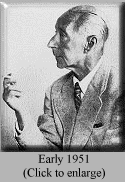
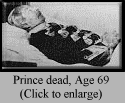 Princess Cecilie remained at
Cecilienhof until February 1945. The Red Army was fast advancing on
Berlin. She decided to go west, where she stayed with the family of the
Kaiser's former court physician in the town of Kissingen. In October
1945 she managed to meet her husband in Hechingen, the erstwhile seat
of the Hohenzollerns. They met a few more times, but did not even
consider living together; they had grown apart. In 1946 the Prince once
more appeared on the public scene as a witness at the Nuremberg trials.
After that, all was quiet around him. On July 20, 1951 the German Crown
Prince died of a heart attack at the age of 69. His son, Prince Louis
Ferdinand, said after the death of his father " I believe, he died of a
broken heart. Not only did he have to denounce his right to the throne,
but twice he had to live through the collapse
of Germany. He had lost two sons, (Prince Hubertus died in 1950 at age
41) and then he lived alone with
his few earthly possessions he was able to save out of all this chaos.
He lived in this small House in Hechingen, where he was stranded,
looking daily up to the ancestral Burg, where so many hundred years
before his ancestors had begun their unbelievable glorious ascent."
Princess Cecilie remained at
Cecilienhof until February 1945. The Red Army was fast advancing on
Berlin. She decided to go west, where she stayed with the family of the
Kaiser's former court physician in the town of Kissingen. In October
1945 she managed to meet her husband in Hechingen, the erstwhile seat
of the Hohenzollerns. They met a few more times, but did not even
consider living together; they had grown apart. In 1946 the Prince once
more appeared on the public scene as a witness at the Nuremberg trials.
After that, all was quiet around him. On July 20, 1951 the German Crown
Prince died of a heart attack at the age of 69. His son, Prince Louis
Ferdinand, said after the death of his father " I believe, he died of a
broken heart. Not only did he have to denounce his right to the throne,
but twice he had to live through the collapse
of Germany. He had lost two sons, (Prince Hubertus died in 1950 at age
41) and then he lived alone with
his few earthly possessions he was able to save out of all this chaos.
He lived in this small House in Hechingen, where he was stranded,
looking daily up to the ancestral Burg, where so many hundred years
before his ancestors had begun their unbelievable glorious ascent."
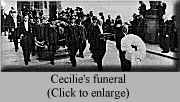 In 1952, Princess Cecilie moved into a
house in Stuttgart, which her son Prince Louis Ferdinand had built for
her. She became ill and died two years later at age 68 on May 6, 1954.
It was the birthday of the Crown Prince. She was laid to rest beside
her husband in the family vault of Burg Hohenzollern in Hechingen.
In 1952, Princess Cecilie moved into a
house in Stuttgart, which her son Prince Louis Ferdinand had built for
her. She became ill and died two years later at age 68 on May 6, 1954.
It was the birthday of the Crown Prince. She was laid to rest beside
her husband in the family vault of Burg Hohenzollern in Hechingen.
In 1993, the restoration of the Kaiser's family Church (The Berlin cathedral or Dom) had far enough advanced to have an official opening. The cathedral received a direct hit during an air raid in WW2, and for 18 years it was painstakingly restored. On June 6, 1993 finally was the big day. In the presence of hundreds of invited guests, as well as Chancellor Helmut Kohl, the guest of honor was the 85-year-old son of Germany's last Crown Prince, His Imperial Highness The Prince Louis Ferdinand. Deutsche Welle TV Berlin televised the opening ceremonies around the world. The Prince was overcome with emotions and in his own words " was thankful to have lived to see this day, where this beautiful Church in which he was christened in 1907, was restored to its former splendor." Prince Louis Ferdinand died in 1996 at age 89.
 for more.
for more.